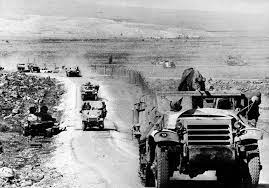Saturday, the sixth of October 1973 AD, corresponding to the tenth of Ramadan 1393 AH, Egypt and Syria launched a war against Israel, to regain the Egyptian land of Sinai and the occupied Syrian Golan Heights, before the shooting stopped on the 24th of the same month.
According to the Arabic name, it is the “War of the Tenth of Ramadan” or “The Sixth of October,” and according to the Israeli name, it is the “Yom Kippur War” or “Yom Kippur War,” which is the fourth war taking place between the Arabs and Israel after the wars of 1948, 1956, and 1967.
Prelude to war
During the era of the late Egyptian President Gamal Abdel Nasser (1956-1970), Egypt was resoundingly defeated in the war of June 7, 1967, as Sinai, Gaza, and the Golan fell into the hands of Israel, followed by the West Bank and Jerusalem.
After months of the historical setback, the epic of liberating Sinai and preparations for the war of liberation began, and in June 1968 the war of attrition began, which transferred the Egyptian strategy from the stage of steadfastness to the stage of deterrence.
On September 28, 1970, President Abdel Nasser died, and Mohamed Anwar Sadat took office after him, who had no choice but to prepare for the liberation of the occupied land, which continued for more than two years
Video duration: 02 minutes 16 seconds02:16
In April 1973, that is, 6 months before the war, Iraq sent about 20 British Hawker Hunter aircraft to Egypt with their pilots, according to a prior agreement between the governments of the two countries as a form of air cooperation. The reason would later become clear. The truth behind this agreement.
advertisement
The Soviets advised President Sadat to choose October 6, 1973, to cross the Suez Canal and begin the attack on the Israeli army, and the senior Russian advisor, General Vasiliovich, recommended “Yom Kippur” as the best time for the attack to achieve the element of surprise.
Soviet intelligence usually launched satellites 2 or 3 times a month, but starting on October 3, 1973, 7 satellites were launched to cover the Middle East, lasting 17 days, and the first satellite was placed in orbit 3 days before the attack.
On May 31, 1974, the war officially ended with the signing of the Disengagement Agreement (Contemporary Egypt Memory)
Highlights
The war began on Saturday, October 6, 1973, with a surprise attack by the Egyptian army and the Syrian army on the Israeli forces that were stationed in Sinai and the Golan Heights.
Egyptian forces penetrated 20 kilometers east of the Suez Canal, and Syrian forces were able to enter deep into the Golan Heights.
The two most powerful countries in the world at the time (America and the Soviet Union) intervened in the war indirectly, as the Soviet Union and Czechoslovakia provided Syria and Egypt with weapons, while the United States provided Israel with military equipment.
On October 12, 1973, that is, 6 days after the start of the war, Israeli Prime Minister Golda Meir called for help from America, which established an unprecedented air bridge in its history to transfer advanced weapons to Israel, while the fighting was continuing to avoid what US Secretary of State Henry Kissinger described as a disaster. .
advertisement
The United States, with its satellites, helped guide the Israelis to the destination of the main Egyptian strikes, the map of the deployment of SAM defenses (surface-to-air missiles), as well as to the weak point in the distance between the Second and Third Armies, which the Israelis eventually penetrated and crossed the canal into Egyptian territory.
Israel also launched a counterattack on the Syrian front in the Golan Heights, and was aided in this by the calm of the Egyptian front as a result of the tactical stance.
Syria asked Egypt to develop the attack on the Egyptian front to relieve Israeli pressure on the Syrian front, and here the disagreement occurred between the Egyptian leaders regarding the form of the development plan.
With American assistance, Israel obtained complete information about the Egyptian forces east and west of the canal, the size of the development forces, and the direction of the main axis.
On the morning of October 14, 1973, Sadat decided to develop the attack eastward to push the enemy west of the mountain passes to restrict his movement and to relieve pressure on the Syrian front, despite the objection of Chief of Staff Saad al-Din al-Shazly.
The Egyptian development forces launched and fell into an Israeli ambush, which led to heavy losses among them. The largest tank battle took place in which about 2,000 Israeli tanks and modern equipment arrived in Israel from America via the air bridge.
Israel destroyed 250 Egyptian tanks, so the development forces withdrew and returned to the bridgeheads, and the development failed, and the Egyptian forces were forced to stop fighting on their front due to the exposure of the back of their forces to the enemy, and the near exhaustion of ammunition, and as a result of America creating an air bridge of equipment for Israel deep in Sinai, as well as I did it in the Golan Heights in Syria.
On the night of October 14, 1973, a small Israeli force was able to cross the Suez Canal to its western bank, and began encircling the Egyptian Third Army, which caused a gap between the ranks of the Egyptian forces known as the “Defressoir Gap.”
On October 17, 1973, Israel pushed its forces across the Bitter Lakes, took control of the crossing area after suffering heavy losses, and set up a bridge on the Suez Canal in the Deversoir area for tanks to cross and flow through the breach.
advertisement
Three Israeli divisions crossed to the western side and took control of a large area that extended to the outskirts of the city of Suez.
On October 21, 1973, the Security Council issued a ceasefire resolution and Israel and Egypt accepted it. However, Israel pushed new forces to the west of the canal on October 22 and 23 to reinforce its forces in the Deversoir area.
Israel continued to fight, and advanced until it reached the rear of the Third Army to cut off the Egypt-Suez desert road and seize the city of Suez. On October 23, the Security Council issued another resolution to confirm the ceasefire, and Egypt and Israel also agreed to it.
Sadat asked the Soviet Union and America to send forces to ensure a ceasefire. The Soviet Union accepted and America strongly objected, but the fighting stopped on October 24.
Official photos of the October War Operations Room (Sadat website/Alexandria University)
Disengagement
On May 31, 1974, the war officially ended with the signing of the Disengagement Agreement, whereby Israel agreed to return the city of Quneitra to Syria and the eastern bank of the Suez Canal to Egypt, in exchange for the removal of Egyptian and Syrian forces from the armistice line and the establishment of a special United Nations force to monitor the implementation of the agreement.
US Secretary of State Henry Kissinger worked as a mediator between the two sides and reached a truce agreement, and the two sides later signed a comprehensive peace agreement at Camp David in 1979.
advertisement
Results of the October War
- Restoration of full Egyptian sovereignty over the Suez Canal and the return of navigation in the canal starting in June 1975.
- Egypt regained all its lands in the Sinai Peninsula.
- Syria regained part of the Golan Heights, including the city of Quneitra.
- The war paved the way for the Camp David Accords between Egypt and Israel, which was signed in September 1978 following Anwar Sadat’s initiative in November 1977 to visit Jerusalem.
Arab losses in the October War
- 8,528 civilians and soldiers were killed, and 19,549 were wounded.
- Egypt: 500 tanks, 120 warplanes, and 15 helicopters destroyed.
- Syria: 500 tanks, 117 warplanes, and 13 helicopters destroyed.
- Iraq: 137 tanks and 26 warplanes destroyed.
- Jordan: 18 tanks destroyed.
Israeli losses in the October War
- 2,656 dead, and 7,250 wounded.
- More than 340 prisoners.
- 400 tanks were destroyed, and other tanks were seized by the Arab armies.
- Destroying more than 300 warplanes and 25 helicopters.


